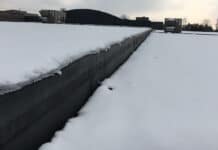By Chris Metcalf and Randy Novak
Winter storms are hitting states around the country, bringing with them severe snow, ice, and sleet. While snow days conjure warm memories of staying home, sledding, and drinking hot chocolate for home and property owners, it’s not all fun and games for grounds teams. It’s imperative they keep sidewalks, parking lots, and roads clear to ensure the area is safe for all.
While there are many ways to keep property clear of snow and ice with melting products, solutions like salt and certain types of ice melt can have negative effects on the surrounding environment. Road salt can contaminate drinking water, kill, or endanger wildlife, increase soil erosion, and damage private and public property. For example, a study in the Journal of Environmental Science and Technology showed that 24% of drinking wells were contaminated by salt that had been used on roads (https://nyti.ms/3oji2zc).

At SSC Services for Education, we’re helping school districts, colleges, and universities across the country tackle snow removal and take measures to make salting and other approaches more environmentally-friendly. First, you must determine the right ice melt solution for the job. Consider the specific characteristics of each type of salt available. Look at the effective lowest temperature and understand the negative effects salt has, and mitigate when possible. Always verify that any site you’re considering for salting at is not listed as a salt sensitive zone. Always mechanically clear new snow accumulations prior to any deicing applications and do not use salt to burn off multiple inches of snow.
Straight rock salt is the most cost-efficient product to use but it is also the most corrosive and causes the most negative environmental effects. Treated rock salt is a better option. There is greater surface adherence and less bounce than regular rock salt. You use less product, and it melts to a lower temperature. It is treated with either calcium or magnesium chloride liquid which helps improve performance. It is also less corrosive and is colored so you can see where you are putting it.
Anti-icing is a proactive approach to decrease the likelihood of snow and ice bonding to the pavement. Using liquid salt brine before a snowstorm is excellent way to reduce your salt usage. Anti-icing with salt brine uses about one-quarter to one-fifth that of traditional deicing. It can save you money as it costs 50% less than reactive deicing. Salt brine is a solution of water and salt that has a freezing point lower than water alone. Brines can be made with sodium, calcium, or magnesium chloride. Salt is mixed in water at a rate of 23.3% salt to 76.7% water. By using a salt brine, you help prevent snow bonding to pavement which allows you to use less salt after the storm. You reduce your salt usage and there are fewer chlorides running into rivers and streams.

On sidewalks using rotary brooms rather than plows will help decrease your salt usage. Brooms clear snow to bare pavement. When salting, use drop spreaders to ensure the product is only applied where it is needed. Use electric drop spreaders that are 48 inches wide to apply salt. Typical sidewalks are 60-72 inches wide. These spreaders are meticulously calibrated and places the salt working from the center point to within 6 or 12 inches from the sidewalk edge. This allows applications to work from the center out, reducing amount applied and amount of overspread into lawns and or shrub beds.
Calculating the amount of ice melt is a very important part of a winter salting program. Salt usage should be based on surface and air temperatures. Surface temperatures can be taken by a handheld infrared sensor or by a truck-mounted unit. Using a salt usage calculator is a great way to determine the recommended product application for a certain product according to surface temperatures. Calibrating your salt spreaders is very important to ensure you are putting out the correct amount of salt down. Calibrate your salt spreader before the season starts and two or three times during the season to make sure your application rate has not changed. By calibrating spreaders, this ensures you are not putting down excess material reducing environmental exposure and maintaining your budget.
Beet juice is a popular ice melt option that lowers the freezing point of water and helps deicers stick to the ground better. It is not corrosive to vehicles, and it does reduce the amount of chloride deicers you would need to clear your walkways or parking lots. Combining rock salt with beet juice does not eliminate the need for chloride deicers. You are still primarily using chlorides; you’re just trying to use chlorides more strategically. Beet juice is highly regarded as an environmentally friendly option to consider but more research is needed to determine how environmentally safe it is. Calcium magnesium acetate is another safer ice melt option. It has low corrosion impact and is rated about as corrosive as tap water. It is safer for the environment and is fully biodegradable. This product is considerably more expensive but is very effective for concrete areas that cannot suffer any damage such as parking garages.
The best way to reduce chloride salts from impacting the environment is to reduce the amount applied to roadways, parking lots, and sidewalks while not compromising safety. Although some deicing chemicals are more environmentally friendly than others it is the misuse of chemicals that is the overriding factor that harms the environment the most. Creative and sustainable ice melt options are out there, and it is up to you, the manager, to incorporate these options into your overall salting program. It is important to be diligent, proactive, and smart in your salting practices. Protecting people is paramount during snow and ice storms, but it doesn’t need to happen at the expense of the planet.
 Metcalf, CGM, CSFM, CSP, and Certified Arborist is a Grounds Project Manager with leading facilities management provider SSC Services for Education. In his 20+ years with the company, Metcalf has played an integral role in in helping SSC provide essential landscaping practices at universities and K-12 schools across the country.
Metcalf, CGM, CSFM, CSP, and Certified Arborist is a Grounds Project Manager with leading facilities management provider SSC Services for Education. In his 20+ years with the company, Metcalf has played an integral role in in helping SSC provide essential landscaping practices at universities and K-12 schools across the country.

Novak is a Grounds Manager for SSC Services for Education at the University of Wisconsin – Green Bay. He earned a degree in applied science from Anoka Technical College. In his year with SSC, Novak has played an integral role in helping SSC provide essential landscaping practices at University of Wisconsin – Green Bay.
Click here and here for more news items and stories related to Snow Management and Facilities. Read more on Snow & Ice Management from Turf magazine, sister publication of Facility Executive.

















![[VIDEO] Collect Asset Data at the Speed of Walking a Building](https://facilityexecutive.com/wp-content/uploads/2024/02/maxresdefault-324x160.jpg)